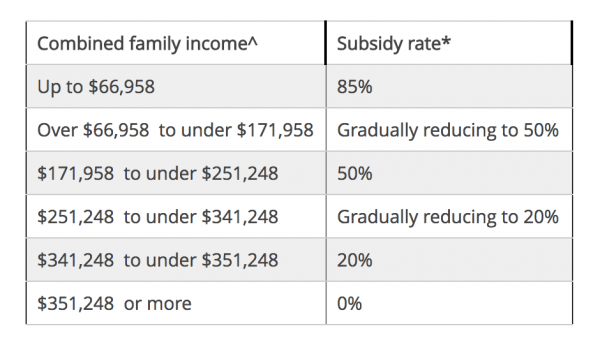
This author is known to Mamamia and has requested to remain anonymous to protect their family’s privacy.
If you’re not spending most of your income on people who aren’t you, how do you even know you’re a parent?
It’s just one of the things parents accept about parenting: kids are expensive, and they will regularly deplete your energy – and your wallets. (But it’s all worth it for those darling angels, of course.)
We are very lucky in this country that if you’re a parent, there are different sorts of government supports available, whether you work or not. In terms of child care, the Department of Education and Training has published this table to demonstrate what the new Child Care Subsidy, which comes into effect today, means for families:


Top Comments
What a strange article this is. You actually have to defend the concept of why wealthy people shouldn't have their childcare paid for by the government? I'm actually surprised that the subsidies go up as far as they do. I would have expected them to taper off once the salaries get up into the six figure range. I know a fellow who was making ~$120,000/year and told his wife that he made plenty of made so she didn't need to work. And it was true. They were comfortably well off and she did a wonderful job raising their three boys and was very happy.
Even more strange is the idea that someone would be pressed to ask whether it is worth it for them to work at all. Where I come from, parents aren't working just for fun, it's because they have to. They can't pay the bills on a single income. So for a person who can afford to stay home and raise their children, but would rather work all day and have the government subsidize the childcare (that wouldn't be needed if a parent was home with the children) is just a completely alien concept. Why be a parent if you want no part in raising them?
Well it is a lot of money but some of us may earn that and have expenses we can’t get out of like the 4K a month under a binding child support agreement. That eats into the 350k a year pretty quickly after tax.
So, if half of your money went to taxes, you'd be down to 175k per year. Minus the 48k in binding child support, and you're left with 127000. Let's even round that down to 120k.
Is that not enough to comfortably live off of? I tried looking up what the Australian middle class was, as a standard of comparison, and found this little tidbit: "The standard of living afforded by a disposable income close to $70,000 is comfortable by any measure". So 70k is comfortable, 120k...is not?
Perhaps if you adjusted your standard of living to be more consistent with your income (or even a lower tier of income), then you would have more flexibility regardless of what subsidies you may qualify for. Just a thought.